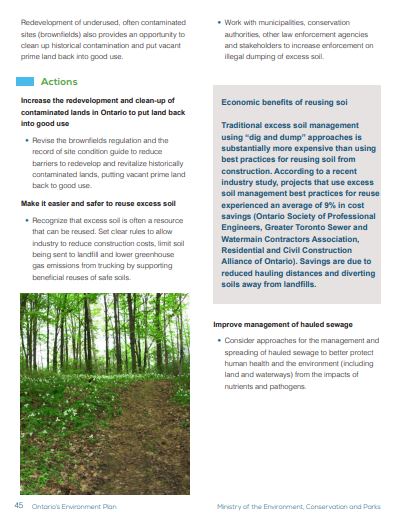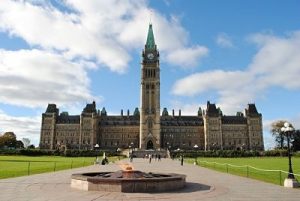The Ministry of the Environment, Conservation and Parks’ released its Made-in-Ontario Environment Plan today. OSPE was invited by the Ministry to attend an invite-only closed door preview of the plan before its release.

our Environment for
Future Generations: A Made-in-Ontario Environment Plan, which references 2016 OSPE report.
While the environment plan is vague on new targets, it is focused on Clear Air, Land and Water. The plan’s one specific goal regarding climate change is to remain in line with the Paris Agreement by continuing to reduce Ontario’s emissions by 30% below 2005 levels by 2030.
Although the plan lacks new, clear commitments, OSPE was pleased to see that the section on clean soil includes recommendations that came straight from Ontario’s engineers. The government has committed to making it easier and safer to reuse excess soil, quoting OSPE’s Excess Soil Management: Ontario is Wasting a Precious Resource report, prepared in partnership with the Residential and Civil Construction Alliance of Ontario and the Greater Toronto Sewer and Watermain Construction Association: “Ontario projects that use excess soil management experienced an average of 9% in cost savings.” Engineers look forward to working with the Minister to implement recommendations around the use of excess soil throughout Ontario.
Some highlights of ideas presented on climate change within the Made-in-Ontario Environment Plan:
- Undertake a provincial impact assessment to identify where and how climate change is likely to impact Ontario’s communities, critical infrastructure, economies and natural environment
- Establish an advisory panel on climate change that will provide advice to the Minister on implementation and further development of actions and activities specific to climate change
- Create an online tool that makes climate change information available to everyone
- Modernize the Building Code to better equip homes and buildings to withstand extreme weather events
- Establish an Ontario Carbon Trust – $400 million over 4 years to an emission reduction fund that will use public funds to leverage private investment in clean technologies that are commercially viable
- “Regulate large emitters with a system that is tough but fair” but allows the province to grant across-the-board exemptions
- Develop a Climate Change Governance Framework – encourage all levels of government to consider climate change in decision-making across the province
What do you think about the government’s plan? Comment below or send your suggestions directly to government on the Environmental Registry – consultation closes on January 28, 2019.






The points are good, but number 6 is bizarre and steps backwards, and number 7 is a reactionary approach instead of a proactive approach. Number 7 invites municipalities to build infrastructure that can withstand climate change, as opposed to encourage municipalities to reduce emissions. Although the new government has taken a step backwards by not involving engineers in decision making, it is good that the results of the soil report have been accepted. As long as there is again, not the latitude given to companies to remediate disturbed land with soil that is not equivalent to the original condition.